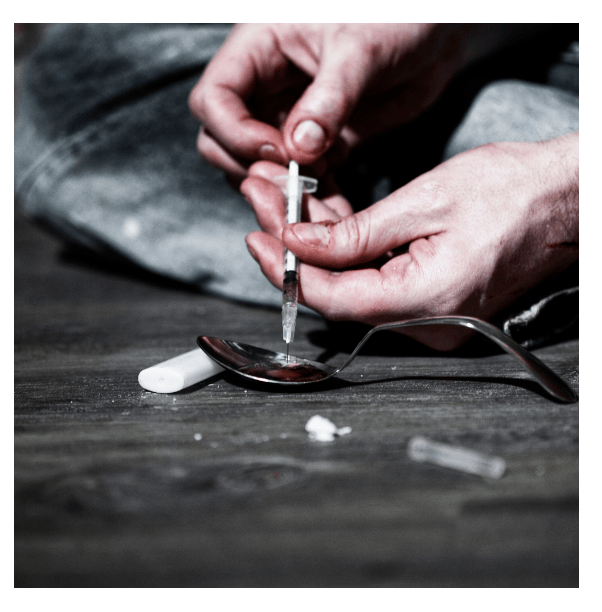

Heroin. Dope. Smack. Snow. It’s one of the most commonly abused street drugs in the U.S. An estimated 1.1 million people in the nation reported using heroin in 2021. And that’s people aged 12 and older. (Yes, we said age 12.)
This highly-addictive street drug is known for delivering an intensely euphoric high, which would explain why people are drawn to it. Due to the high only lasting around an hour, a rapidly escalating and dangerous addiction is highly probable.
But what is heroin, exactly? Is heroin a stimulant? A depressant? Let’s take a look into this dangerous street drug to get a better idea of what it is, what it does to your body and mind, and how you can get help if you’ve found yourself battling heroin addiction.
The 5 Stages of Addiction Recovery
What is Heroin, Anyway?
The seed pod of opium poppy plants is the source of all non-synthetically generated opioids, including heroin. Made from morphine (drawn from the opium poppy plant), it comes in the form of powder which can be white or brown, and a black sticky substance called black tar heroin.
Most heroin sold on the streets isn’t considered “pure” since it’s mixed (or “cut”) with cornstarch, sugars, powdered milk, flour, and talc. Sometimes, quinine is added to white heroin to produce a bitter flavor.
Another extremely dangerous substance dealers can cut with heroin is now the U.S.’s deadliest drug: fentanyl. The highly-addicted illicitly-manufactured drug (IMF) is easy for dealers to get their hands on, increases the potency of any drug it’s added to (including heroin) and is very deadly. It’s 100x stronger than morphine and 50x more potent than heroin. So even the tiniest of amounts cut with heroin could be fatal. And it’s impossible for the naked eye to detect.

Cutting heroin allows drug dealers to increase their supply, meaning they’ll be able to sell more and make additional profit, regardless of what it does to users. In fact, powdered heroin can be cut with rat poison, and black tar heroin can be cut with bacteria-laden soil and even black shoe polish.
Another essential thing to note about heroin is that because it’s typically sold impure, if users accidentally get their hands on illicitly-sold pure heroin, it may lead to overdose.
Heroin can be injected, sniffed, snorted, or smoked, depending on what kind of heroin it is.
- White heroin – White heroin is the hydrochloride salt form of the drug, which easily dissolves in water to be injected. Also called diacetylmorphine hydrochloride, it is typically the purest form of the drug, although it’s often “cut” with other ingredients, as previously mentioned. Typically, the purer white heroin is, the shinier and whiter it is. If white heroin appears dull, it’s likely cut with other ingredients.
- Brown heroin – This form of the drug is either a brown powder or powdery clumps consisting of heroin “base” plus whatever it’s cut with. Unlike white heroin, this form of heroin doesn’t dissolve in water, so it can’t be injected unless mixed with an acid, such as citric acid. Brown heroin vaporizes when heated, so more regularly, it’s smoked or “chased” from foil.
- Black tar heroin – Black tar heroin is produced through a crude process, resulting in a blackish-brown sticky chunk. It’s cheaper and easier to make than powdered heroin and can be smoked or injected.
Overall, you’re probably asking, “So, Is Heroin a Stimulant Or What?”
Getting to the burning question, “Is heroin a stimulant?” – the answer is no. Heroin is not a stimulant. It’s actually the opposite; it’s a depressant.
Depressants like heroin slow down the processes in your body controlled by the central nervous system. Your blood pressure and body temperature can drop, and your heartbeat can become irregular. Finally, this depressant can also go so far as to make you unconscious or go into a coma.
What Are the Dangers of Clonazepam Long-Term Use?

The Short and Long-Term Effects of Heroin Use
Using heroin, even for a short time, can severely impact your health. Because it forces a dopamine release, producing an intense high, there’s a good chance you’ll want to use it again, even if you only “try” it once.
The effects of heroin use are both short and long-term. Short-term effects are instantaneous if the drug is injected intravenously and take about 15 minutes to take effect if snorted. Long-term effects happen over time after continued use. But it’s crucial to note that it only takes one time to overdose on heroin if it’s laced with harmful chemicals or other drugs.
Short-Term Effects of Heroin Use

The short-term effects of heroin use depend on several factors of the user, including the following:
- overall health and metabolism
- dose of heroin used
- purity and potency of the drug
- height and weight of the user
- tolerance level
- presence of other drugs in the user’s body
When heroin is used, the short-term effects include:
- euphoria
- pinpoint pupils
- suppressed appetite
- slurred speech
- relaxation and drowsiness
- slowed heart rate
- heavy feelings in arms and legs
- itchy skin
- clouded mental functioning
- nodding between consciousness and subconsciousness (called going “on the nod”)
- slowed breathing
- nausea
- vomiting
How Naltrexone for Addiction Can Set You Free
Long-Term Effects of Heroin Use
The effects of long-term heroin use can be dangerous. As a result, when you use heroin repeatedly, it changes the physical structure and physiology of your brain, causing long-term neuronal and hormonal system imbalances that are difficult to reverse. A deterioration of white matter in your brain that occurs affects your ability to make decisions, regulate behavior, and respond appropriately to stress.
The long-term effects of heroin use include the following:
- loss of libido
- bouts of extreme sadness
- liver, lung, heart, and brain damage
- increased tolerance which elevates the risk of overdose
- vein and skin damage
- chronic constipation
- irregular menstrual cycles
- difficulty conceiving
- financial, work, and relationship problems
In 2020, over 13,000 people died from overdosing on heroin. Because it is highly addicting and challenging to quit, the more you use, the more at risk you are to overdose.
Finding Heroin Addiction Treatment in San Diego
Quitting using heroin is extremely difficult, especially on your own. When your body becomes dependent, you are likely to experience challenging withdrawal symptoms, which can be dangerous to endure without the supervision of a medical professional.
If you or someone you love is dealing with a heroin addiction, getting addiction treatment in San Diego or wherever you live as soon as possible is critical. Recovery is possible.

Adderall Addiction: Symptoms and Treatment Options
Above all, outpatient detox allows you to receive the help you need at our Encinitas mental health center during the day while still being able to go home at night. Our team of addiction treatment specialists will take the time to get to know you and come to understand your individual needs. From there, they will devise an ideal individualized treatment plan to help you detox heroin from your system.
The next step would be to enroll in our San Diego IOP, where you will attend rigorous therapy sessions three days per week for ten weeks. You’ll speak independently with your assigned clinician, attend group therapy, and receive medication management if needed.

Our outpatient detox and San Diego IOP programs provide the convenient and high-quality support you need to fully recover from heroin addiction and reclaim your life.
Contact us today for more information about these and any of our mental health services options. It only takes one time to use heroin to be dangerous. Finally, no matter how long you or someone you love has used, we can help you recover for good.


